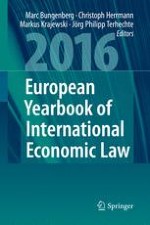2016 | OriginalPaper | Buchkapitel
Trade in Agricultural Products: Should Developing Countries Give Up on the WTO Promise for a Fair and Market-Oriented Agricultural Trading System? A Historical and Theoretical Analysis
verfasst von : Melaku Geboye Desta
Erschienen in: European Yearbook of International Economic Law 2016
Aktivieren Sie unsere intelligente Suche, um passende Fachinhalte oder Patente zu finden.
Wählen Sie Textabschnitte aus um mit Künstlicher Intelligenz passenden Patente zu finden. powered by
Markieren Sie Textabschnitte, um KI-gestützt weitere passende Inhalte zu finden. powered by
